Ant farm. Ant Farm
 Bashny.Net
Bashny.Net
Now in May, and that means it's time to get such an unusual hobby.
Information is saved from rotting pedivikii and brazenly copied from the resources devoted to this topic and antclub.org antclub.ru
I'll let you know when I finish. Please do not break!
Ant farm (lat. Formicarium) - structure for the content or the artificial anthill ants.
The first ant farm designed myrmecology and entomologists for their research in the XIX century. However, the increased interest to naturalists and lovers of the social life of ants has led to a massive expansion of the simplest designs ant farm. The first commercial ant farm was established around 1929 and patented in 1931 by inventor Frank Austin, a professor from the Thayer School of Engineering at Dartmouth College.
The most famous is the ant farm "Ant Farm" Uncle Milton "» (Uncle Milton's Ant Farm), for which the ants are sent to the buyer via e-mail, upon receipt of the payment receipt. In essence, the educational toy is made by the American firm Uncle Milton Industries of California (Westlake Village, California). Since 1956 it has sold more than 20 million ant farm under the brand «Ant Farm».
Ant farm presented various designs from the simplest such as banks filled with filler, finishing with complex closed systems, with automatic support for light level, humidity, temperature.
If you want to create your own home ant farm, then this material is for you.
1. The first thing we recommend is to never take for what strangers. Before you find yourself ants, read the scientific literature on this subject, please refer to their way of life, habits and habits in theory, that did not appear then stupid questions like "What if I take 10 muraveychikov of each family, and mixed, will be a big family? ". Believe me, there were some incidents. You can not know the taxonomy, it comes with time, but to understand who the Formicidae and what the specifics of the family should be clear.
2. Fate has been kind, and you find an ant queen. I have to say, it often happens at the most inconvenient time. The first thing to do - is to understand the species or even genus level. There is a certain percentage of the species of the uterus that can not independently found a new family. They usually need a kind of host.
These are:
Ants group Formica rufa
Lasius fuliginosus
Polyergus rufescens
Formica sanguinea
At the beginning of better not to have and practice a more simple species.
For example Lasius sp., Tetramorium or someone Serviformica.
That will be just below
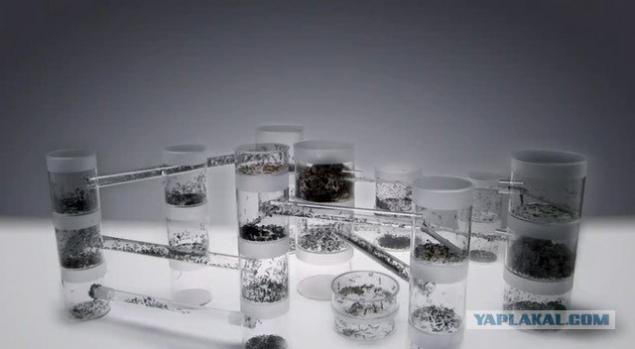
Lasius niger
black garden ant
Probably no man who does not know these ubiquitous little black ants. They are found almost everywhere in the fields, in forests, in gardens, even in the houses and apartments of their colonies is not that unusual sight.
Work of this kind of small - 4-4.5 mm. A pronounced polymorphism no. Despite its name, this is likely not black and dark gray ants. The uterus is much larger than the workers and reaches 10 mm in length.
Young uterus base nest without the help of a native family. As with most other types of black laziusa uterus after mating flight of finds a hiding place under a rock or a fallen tree to give rise to a new colony. The uterus is a family one. Multiple queens can only be in the early stages, when the tab slot (but then, as usual, there is only one). Founding new colonies by budding (as Tetramorium and F.rufa) for laziusov uncharacteristically.
Due to its omnivorous black family laziusov grow very large: from 50,000 to 70,000. An important role is played by symbiosis with various kinds of aphids. Tlinye laziusam colonies are the main source of carbohydrate food. I think we will be a few species in which the symbiosis with the aphids reached such a level. If the ant Myrmica rubra relationship with the aphids are largely seasonal in nature and are not characterized by any impact from the ants, then laziusy strongly guard their fodder colony of ants from predators and from other people's families. But that's not all. Often you can see on a piece of interesting excavation sheds, built by ants as a shelter tlinogo. With the onset of autumn frosts ants carry aphids to the ant cave, and spring again they are suitable for the life of a bush or tree.
Protein foods produced by the destruction of everything that runs, crawls or flies. In this respect, laziusy very aggressive look. Because of its high prevalence and the number represents serious competition for other types of ants.
Author of the form: (Linnaeus, 1758)
Other names: Black garden ant, black ant, garden ant
Dimensions: Working: 3-5mm (Figure 6), male: 4-6mm, the queen: 7-9mm (Figure 9, Figure 5)
Number of queens: monoginiya
Kolonii Size: 10K-50K
Type anthill: mounds, underground, without external structures, with craters from the ground, under rocks
Typical habitat: zapadnopalearktichesky view from Portugal and England across Europe to central Siberia and Mongolia
Wintering: not necessary
Food: omnivorous, aphids and scale insects are bred
Humidity: regular ≈ 94%
Temperature: an ordinary ≈ 28-29 ° C
The complexity of the content: easy
Mobility: fast
Years: July-August
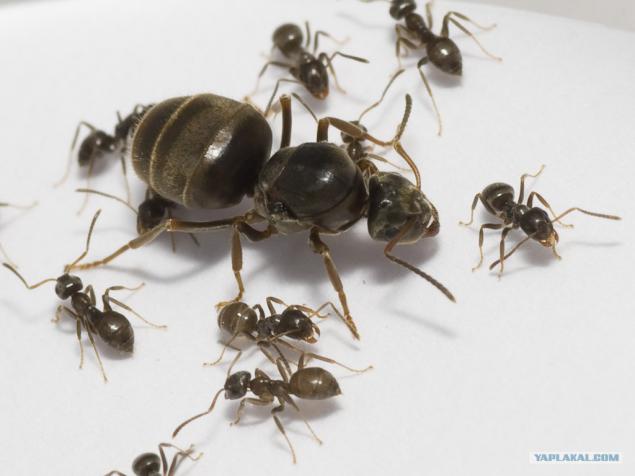
Tetramorium caespitum (turf ant)
The sod ant Tetramorium caespitum, among the most massive. It got its name from the passion for sodding habitats. Boca casing with keeled elevations limiting ahead antennal pits metathorax with small teeth, three-segmented antennal club. It spreads everywhere except the Far North. These small (up to 4mm) ants from light brown to black in color, are found everywhere, even in human dwellings. The ability of turf ants form a so-called diffuse slot (use ready cavities and cameras) makes them very malleable. Penetrating into a person's home, they settled on the possible cracks and shelters, seeping from room to room, they are very difficult to withdraw.
Working Tetramorium caespitum
In nature turf ant is everywhere. It is necessary to lay some bait (sugar, semolina, fruit, etc.), how near it quickly gather ants. This explains why during the war between the feuding families turf ant takes a wait and at the end of the bout rushes to the battlefield, finding dead ants and bites his abdomen, used in food. Thus, predatory ant turf - passive. It is omnivorous. The number of ants in nature is high. Eating residues of animal origin, they perform the role of nurses. Essential role in soil and ants (mixing layer of the soil, improving the water- and air), a mineralization of wood residues and as a food resource for other animals.
Uterus Tetramorium caespitum
The uterus is always the same in the colony, but in spite of this the number of individuals in the family tetramoriumov reaches 80,000. Ants can take a second and uterus, but it is a long time in the anthill is not delayed. However, one of the two queens of the ant leaves his home to establish a new ant hill. This process is called fission. Throughout the summer, you can see how the column tetramoriumov looking for a suitable location for a new anthill.
Author of the form: (Linnaeus, 1758)
Other names: sod ant, pavement ant
Number of queens: monoginiya
Kolonii Size: 10K-50K
Type ant: subsurface, without external structures in decaying wood and under the bark of old stumps, under stones
Wintering: not necessary
Food: omnivorous, need seeds
Humidity: Increased ≈ 98%
Temperature: reduced ≈ 25-27 ° C
The complexity of the content: easy
Mobility: calm
Years: June-July

Serviformica cunicularia (quick steppe ant)
Pretty common form. It is found in Central Europe, also in the south and central Russia.
Painted with two-color: red thorax, abdomen, and head of dark gray. Color thorax queens may vary from completely black and gray to red with three black spots. Changes recorded within a single subspecies. The family found work as small dark with dull colored thorax and large with a bright red breast.
Typically queen establishes a nest on their own. Polygyny is rare for the species. It occurs mainly in the plains, in the meadows of forests, gardens. Collects Pad on the colonies of aphids. Protected areas usually do not have.
Jacks without pronounced overground buildings. Chance of a small hill. Most can be located under the stones.
Author of the form: Latreille, 1798
Other names: quick steppe ant
Dimensions: workers: 7-8 mm (Figure 3), the uterus: 10-11 mm (Figure 4)
Number of queens: monoginiya
Kolonii Size: 5K-10K
Type ant: subsurface, without external structures, under stones
Wintering: no information
Food: omnivorous, aphids and scale insects are bred
Humidity: regular ≈ 94%
Temperature: an ordinary ≈ 28-29 ° C
The complexity of the content: easy
Mobility: fast
Years: From mid-June to mid-August, with the greatest intensity in July
In the photo of the uterus.
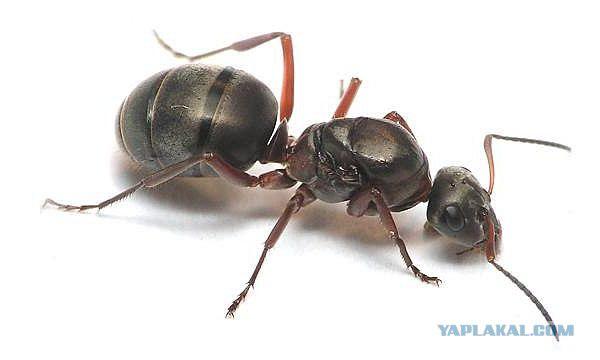
So, we figured out that we for undertakings. And the transition to the third stage:
3. We must prepare for the future queen suites. The ideal situation is a test tube. 1 / 4-1 / 3 of the tube is filled with water, then the aqueous compartment shuts dense fleece. Thus the tube will be maintained in an optimum moisture level.
Throughout the period of the output of the first generation of the uterus does not eat anything. Experience is not necessary, so she would not die, but still it can feed. Now, the uterus needs rest. During this period, it is not necessary to disturb the tube often rearrange include bright light. Forget about it is not worth it, because there is always the chance of any unforeseen accidents. When the first workers' colony should be fed as required and consumption.

4. While the colony has about a dozen workers, the arena is not necessary. Small family fed directly in vitro as a carbohydrate and protein feed.
When the population will grow to such an extent that they become crowded, and the process of feeding, turned into a torture and catch ants, is to take care of the arena.
In the picture the queen of black garden ant colony with nascent in vitro:
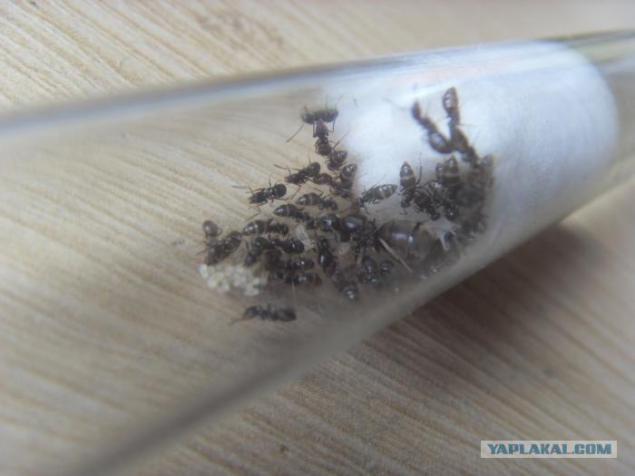
5. Tube with arena
The tube - the best option for the development of the young colony. It is always kept optimal level of humidity, and the air does not stagnate. But there comes a time, and stop the ants to live quietly in a test tube. Even if the volume of the tube allows the colony to live, because is not such a small population becomes difficult to take care of the insects: always someone tries to escape during feeding, accumulated garbage, restless ants interfere with its normal clean, some of the workers are beginning to nibble wool, pieces of which then fill the entire tube. In general, how great was the tube in those days when there lived only the uterus brood so uncomfortable she became, when the "kids" have grown.
There are cases when after the transplant colonies from test tubes in a small ant farm, the colony did not take root and eventually die. In small structures are not always easy to maintain the desired level of humidity, and for species such as Solenopsis fugax it is deadly.
Next design facilitates feeding and caring for the ants, plus the family does not necessarily move to a large ant farm.
Materials needed:
1. A box of chocolates under «FERRERO ROCHER» (or any other plastic container suitable volume. Dimensions: length - 15cm, width - 8 cm, height - 8 cm).
2. The transparent tube diameter 7-8mm (length on the circumstances).
3. Mosquito net.
Progress:
1. In one of the walls of the box need to make a hole whose diameter coincides with the external diameter of the hose-adapter. For these purposes, you can use commercial forest-machine. If the diameter of negligence get more - you can lock the phone and to cover gaps aquarium silicone.
2. Ventilation. With the same boron cars done in the cover of several openings (1-4). Cut slices of mesh (diameter 2-3 mm larger diameter hole) and glue them to the edges of the ventilation openings. Note that commercially available grid does not constitute an obstacle to monomoriumov, and some laziusov tetramoriumov. If the structure will contain one of the above ants, you should advance to find a fine mesh.
3. Feeding. In the center of the cover hole is drilled, similar to the previous ventilation. From scrap materials (for example, from a piece of pipe or styrofoam) cut out a suitable diameter plug. Through this opening, we will supply the ant protein feed.
4. Connect the tubes with the colony. How to connect the hose to the arena, it is clear. Connect the hose to the tube also is not difficult (see. Fig.). Arena is filled with a thin layer of sand or gravel (2-3 mm diameter). You can also add a couple of "natural" elements: stones, twigs, dry leaves, etc. Be creative ...
The result should be something like:
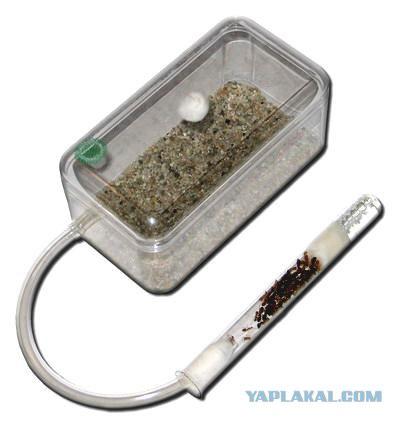
Now let's talk about the already directly ant farm:
The easiest way to make ant farm of something suitable, for example, from a box of chocolates, or containers for bulk products, or from the tank (the list is very long).
Ant farm can be anything! Here are 7 simple rules of any ant farm:
Ant farm, and all its parts must be safe for both you and the ants (not poisonous, do not hurt);
There should be no sharp edges or traumatic. If you use glue - find non-toxic, whether it. Ie ant farm must meet the requirements predyavlyat to containers for food storage.
Ants do not have the freedom to leave for the ant farm set your borders;
Thought out in advance the possible escape routes ants. Many ants quite easily crawl on glass - open wall will need butter or talc to prevent escape. If you, for example, decided to have a small ant (such as Lasius niger), the gap in 1mm is already sufficient to escape.
Ant farm should not be germitichnym, i.e. must be fresh air;
Look, do not overdo it-whether you're in the previous paragraph? The ant farm must arrive fresh air, not a desirable place where the air is stagnant. Provide a small ventilation holes. They can close the fine mesh or cotton wool. At the same time still need to comply with Ballance - drafts highly undesirable. Provide the ability to block the excessive ventilation.
Must be able to influence the level of humidity in the ant farm;
If the filler is used in plaster, then keep the humidity in the ant farm will be much easier. In any case, providing an alternative source of moisture. In the presence of a source of water, the ants themselves are able to regulate the level of moisture in a small range. As desired "moisture gradient" - should be as wet areas and dry.
It must be possible to influence the temperature in the ant farm;
The right temperature (20 ° C to 32 ° C) is very important for the development of the brood. Think about how you will maintain the desired temperature in the ant farm. Overheat much more dangerous than a little cool. As in the previous paragraph is important, "gradient" - should be warm and cool place.
The ant farm should be enough living space for ants;
Overpopulation can negatively affect your future colony. It is best if your ant farm will be a little "with reserve". Another good option - the possibility of a modular extension of your ant farm.
You should be able to free and secure access to some internal parts of the ant farm for feeding and care;
Ie ant farm should be arranged so that at any preventive work people do not have all the crowd ran out and there would be suppressed nechayno you. It is desirable that the camera is living away from the feeding, watering, etc. Any interference with your ants perceive as hostile, and will be protected.
It is minimally necessary set of rules. Even a simple 3-liter jar is more or less satisfies these conditions. / And there were cases of detention of ants in that ant farm. /
And of course, it will be a big plus if the ant farm will be a beautiful addition to your interior. Well decorated ant farm can be extraordinarily beautiful. Plus, the ants get along quite well and unnatural conditions. Ant farm does not have to mimic the wildlife, it can look very unusual. If only the conditions were suitable.

Another

A very interesting specimen:
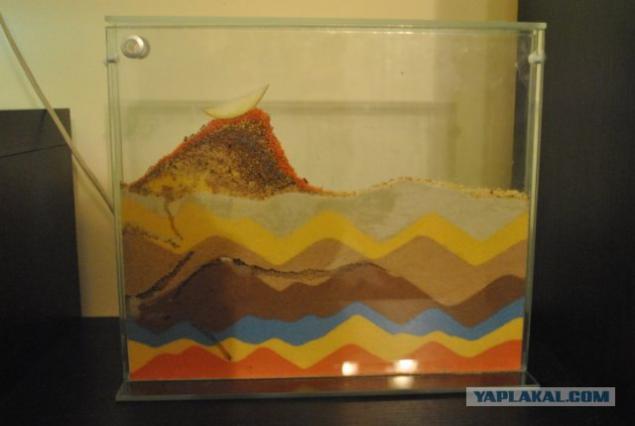
And another.
Next on the feeding:

Feeding
Ie
Source:
Information is saved from rotting pedivikii and brazenly copied from the resources devoted to this topic and antclub.org antclub.ru
I'll let you know when I finish. Please do not break!
Ant farm (lat. Formicarium) - structure for the content or the artificial anthill ants.
The first ant farm designed myrmecology and entomologists for their research in the XIX century. However, the increased interest to naturalists and lovers of the social life of ants has led to a massive expansion of the simplest designs ant farm. The first commercial ant farm was established around 1929 and patented in 1931 by inventor Frank Austin, a professor from the Thayer School of Engineering at Dartmouth College.
The most famous is the ant farm "Ant Farm" Uncle Milton "» (Uncle Milton's Ant Farm), for which the ants are sent to the buyer via e-mail, upon receipt of the payment receipt. In essence, the educational toy is made by the American firm Uncle Milton Industries of California (Westlake Village, California). Since 1956 it has sold more than 20 million ant farm under the brand «Ant Farm».
Ant farm presented various designs from the simplest such as banks filled with filler, finishing with complex closed systems, with automatic support for light level, humidity, temperature.
If you want to create your own home ant farm, then this material is for you.
1. The first thing we recommend is to never take for what strangers. Before you find yourself ants, read the scientific literature on this subject, please refer to their way of life, habits and habits in theory, that did not appear then stupid questions like "What if I take 10 muraveychikov of each family, and mixed, will be a big family? ". Believe me, there were some incidents. You can not know the taxonomy, it comes with time, but to understand who the Formicidae and what the specifics of the family should be clear.
2. Fate has been kind, and you find an ant queen. I have to say, it often happens at the most inconvenient time. The first thing to do - is to understand the species or even genus level. There is a certain percentage of the species of the uterus that can not independently found a new family. They usually need a kind of host.
These are:
Ants group Formica rufa
Lasius fuliginosus
Polyergus rufescens
Formica sanguinea
At the beginning of better not to have and practice a more simple species.
For example Lasius sp., Tetramorium or someone Serviformica.
That will be just below

Lasius niger
black garden ant
Probably no man who does not know these ubiquitous little black ants. They are found almost everywhere in the fields, in forests, in gardens, even in the houses and apartments of their colonies is not that unusual sight.
Work of this kind of small - 4-4.5 mm. A pronounced polymorphism no. Despite its name, this is likely not black and dark gray ants. The uterus is much larger than the workers and reaches 10 mm in length.
Young uterus base nest without the help of a native family. As with most other types of black laziusa uterus after mating flight of finds a hiding place under a rock or a fallen tree to give rise to a new colony. The uterus is a family one. Multiple queens can only be in the early stages, when the tab slot (but then, as usual, there is only one). Founding new colonies by budding (as Tetramorium and F.rufa) for laziusov uncharacteristically.
Due to its omnivorous black family laziusov grow very large: from 50,000 to 70,000. An important role is played by symbiosis with various kinds of aphids. Tlinye laziusam colonies are the main source of carbohydrate food. I think we will be a few species in which the symbiosis with the aphids reached such a level. If the ant Myrmica rubra relationship with the aphids are largely seasonal in nature and are not characterized by any impact from the ants, then laziusy strongly guard their fodder colony of ants from predators and from other people's families. But that's not all. Often you can see on a piece of interesting excavation sheds, built by ants as a shelter tlinogo. With the onset of autumn frosts ants carry aphids to the ant cave, and spring again they are suitable for the life of a bush or tree.
Protein foods produced by the destruction of everything that runs, crawls or flies. In this respect, laziusy very aggressive look. Because of its high prevalence and the number represents serious competition for other types of ants.
Author of the form: (Linnaeus, 1758)
Other names: Black garden ant, black ant, garden ant
Dimensions: Working: 3-5mm (Figure 6), male: 4-6mm, the queen: 7-9mm (Figure 9, Figure 5)
Number of queens: monoginiya
Kolonii Size: 10K-50K
Type anthill: mounds, underground, without external structures, with craters from the ground, under rocks
Typical habitat: zapadnopalearktichesky view from Portugal and England across Europe to central Siberia and Mongolia
Wintering: not necessary
Food: omnivorous, aphids and scale insects are bred
Humidity: regular ≈ 94%
Temperature: an ordinary ≈ 28-29 ° C
The complexity of the content: easy
Mobility: fast
Years: July-August

Tetramorium caespitum (turf ant)
The sod ant Tetramorium caespitum, among the most massive. It got its name from the passion for sodding habitats. Boca casing with keeled elevations limiting ahead antennal pits metathorax with small teeth, three-segmented antennal club. It spreads everywhere except the Far North. These small (up to 4mm) ants from light brown to black in color, are found everywhere, even in human dwellings. The ability of turf ants form a so-called diffuse slot (use ready cavities and cameras) makes them very malleable. Penetrating into a person's home, they settled on the possible cracks and shelters, seeping from room to room, they are very difficult to withdraw.
Working Tetramorium caespitum
In nature turf ant is everywhere. It is necessary to lay some bait (sugar, semolina, fruit, etc.), how near it quickly gather ants. This explains why during the war between the feuding families turf ant takes a wait and at the end of the bout rushes to the battlefield, finding dead ants and bites his abdomen, used in food. Thus, predatory ant turf - passive. It is omnivorous. The number of ants in nature is high. Eating residues of animal origin, they perform the role of nurses. Essential role in soil and ants (mixing layer of the soil, improving the water- and air), a mineralization of wood residues and as a food resource for other animals.
Uterus Tetramorium caespitum
The uterus is always the same in the colony, but in spite of this the number of individuals in the family tetramoriumov reaches 80,000. Ants can take a second and uterus, but it is a long time in the anthill is not delayed. However, one of the two queens of the ant leaves his home to establish a new ant hill. This process is called fission. Throughout the summer, you can see how the column tetramoriumov looking for a suitable location for a new anthill.
Author of the form: (Linnaeus, 1758)
Other names: sod ant, pavement ant
Number of queens: monoginiya
Kolonii Size: 10K-50K
Type ant: subsurface, without external structures in decaying wood and under the bark of old stumps, under stones
Wintering: not necessary
Food: omnivorous, need seeds
Humidity: Increased ≈ 98%
Temperature: reduced ≈ 25-27 ° C
The complexity of the content: easy
Mobility: calm
Years: June-July

Serviformica cunicularia (quick steppe ant)
Pretty common form. It is found in Central Europe, also in the south and central Russia.
Painted with two-color: red thorax, abdomen, and head of dark gray. Color thorax queens may vary from completely black and gray to red with three black spots. Changes recorded within a single subspecies. The family found work as small dark with dull colored thorax and large with a bright red breast.
Typically queen establishes a nest on their own. Polygyny is rare for the species. It occurs mainly in the plains, in the meadows of forests, gardens. Collects Pad on the colonies of aphids. Protected areas usually do not have.
Jacks without pronounced overground buildings. Chance of a small hill. Most can be located under the stones.
Author of the form: Latreille, 1798
Other names: quick steppe ant
Dimensions: workers: 7-8 mm (Figure 3), the uterus: 10-11 mm (Figure 4)
Number of queens: monoginiya
Kolonii Size: 5K-10K
Type ant: subsurface, without external structures, under stones
Wintering: no information
Food: omnivorous, aphids and scale insects are bred
Humidity: regular ≈ 94%
Temperature: an ordinary ≈ 28-29 ° C
The complexity of the content: easy
Mobility: fast
Years: From mid-June to mid-August, with the greatest intensity in July
In the photo of the uterus.

So, we figured out that we for undertakings. And the transition to the third stage:
3. We must prepare for the future queen suites. The ideal situation is a test tube. 1 / 4-1 / 3 of the tube is filled with water, then the aqueous compartment shuts dense fleece. Thus the tube will be maintained in an optimum moisture level.
Throughout the period of the output of the first generation of the uterus does not eat anything. Experience is not necessary, so she would not die, but still it can feed. Now, the uterus needs rest. During this period, it is not necessary to disturb the tube often rearrange include bright light. Forget about it is not worth it, because there is always the chance of any unforeseen accidents. When the first workers' colony should be fed as required and consumption.

4. While the colony has about a dozen workers, the arena is not necessary. Small family fed directly in vitro as a carbohydrate and protein feed.
When the population will grow to such an extent that they become crowded, and the process of feeding, turned into a torture and catch ants, is to take care of the arena.
In the picture the queen of black garden ant colony with nascent in vitro:

5. Tube with arena
The tube - the best option for the development of the young colony. It is always kept optimal level of humidity, and the air does not stagnate. But there comes a time, and stop the ants to live quietly in a test tube. Even if the volume of the tube allows the colony to live, because is not such a small population becomes difficult to take care of the insects: always someone tries to escape during feeding, accumulated garbage, restless ants interfere with its normal clean, some of the workers are beginning to nibble wool, pieces of which then fill the entire tube. In general, how great was the tube in those days when there lived only the uterus brood so uncomfortable she became, when the "kids" have grown.
There are cases when after the transplant colonies from test tubes in a small ant farm, the colony did not take root and eventually die. In small structures are not always easy to maintain the desired level of humidity, and for species such as Solenopsis fugax it is deadly.
Next design facilitates feeding and caring for the ants, plus the family does not necessarily move to a large ant farm.
Materials needed:
1. A box of chocolates under «FERRERO ROCHER» (or any other plastic container suitable volume. Dimensions: length - 15cm, width - 8 cm, height - 8 cm).
2. The transparent tube diameter 7-8mm (length on the circumstances).
3. Mosquito net.
Progress:
1. In one of the walls of the box need to make a hole whose diameter coincides with the external diameter of the hose-adapter. For these purposes, you can use commercial forest-machine. If the diameter of negligence get more - you can lock the phone and to cover gaps aquarium silicone.
2. Ventilation. With the same boron cars done in the cover of several openings (1-4). Cut slices of mesh (diameter 2-3 mm larger diameter hole) and glue them to the edges of the ventilation openings. Note that commercially available grid does not constitute an obstacle to monomoriumov, and some laziusov tetramoriumov. If the structure will contain one of the above ants, you should advance to find a fine mesh.
3. Feeding. In the center of the cover hole is drilled, similar to the previous ventilation. From scrap materials (for example, from a piece of pipe or styrofoam) cut out a suitable diameter plug. Through this opening, we will supply the ant protein feed.
4. Connect the tubes with the colony. How to connect the hose to the arena, it is clear. Connect the hose to the tube also is not difficult (see. Fig.). Arena is filled with a thin layer of sand or gravel (2-3 mm diameter). You can also add a couple of "natural" elements: stones, twigs, dry leaves, etc. Be creative ...
The result should be something like:

Now let's talk about the already directly ant farm:
The easiest way to make ant farm of something suitable, for example, from a box of chocolates, or containers for bulk products, or from the tank (the list is very long).
Ant farm can be anything! Here are 7 simple rules of any ant farm:
Ant farm, and all its parts must be safe for both you and the ants (not poisonous, do not hurt);
There should be no sharp edges or traumatic. If you use glue - find non-toxic, whether it. Ie ant farm must meet the requirements predyavlyat to containers for food storage.
Ants do not have the freedom to leave for the ant farm set your borders;
Thought out in advance the possible escape routes ants. Many ants quite easily crawl on glass - open wall will need butter or talc to prevent escape. If you, for example, decided to have a small ant (such as Lasius niger), the gap in 1mm is already sufficient to escape.
Ant farm should not be germitichnym, i.e. must be fresh air;
Look, do not overdo it-whether you're in the previous paragraph? The ant farm must arrive fresh air, not a desirable place where the air is stagnant. Provide a small ventilation holes. They can close the fine mesh or cotton wool. At the same time still need to comply with Ballance - drafts highly undesirable. Provide the ability to block the excessive ventilation.
Must be able to influence the level of humidity in the ant farm;
If the filler is used in plaster, then keep the humidity in the ant farm will be much easier. In any case, providing an alternative source of moisture. In the presence of a source of water, the ants themselves are able to regulate the level of moisture in a small range. As desired "moisture gradient" - should be as wet areas and dry.
It must be possible to influence the temperature in the ant farm;
The right temperature (20 ° C to 32 ° C) is very important for the development of the brood. Think about how you will maintain the desired temperature in the ant farm. Overheat much more dangerous than a little cool. As in the previous paragraph is important, "gradient" - should be warm and cool place.
The ant farm should be enough living space for ants;
Overpopulation can negatively affect your future colony. It is best if your ant farm will be a little "with reserve". Another good option - the possibility of a modular extension of your ant farm.
You should be able to free and secure access to some internal parts of the ant farm for feeding and care;
Ie ant farm should be arranged so that at any preventive work people do not have all the crowd ran out and there would be suppressed nechayno you. It is desirable that the camera is living away from the feeding, watering, etc. Any interference with your ants perceive as hostile, and will be protected.
It is minimally necessary set of rules. Even a simple 3-liter jar is more or less satisfies these conditions. / And there were cases of detention of ants in that ant farm. /
And of course, it will be a big plus if the ant farm will be a beautiful addition to your interior. Well decorated ant farm can be extraordinarily beautiful. Plus, the ants get along quite well and unnatural conditions. Ant farm does not have to mimic the wildlife, it can look very unusual. If only the conditions were suitable.

Another

A very interesting specimen:

And another.
Next on the feeding:

Feeding
Ie
Source:
Tags
See also
The story of kiwi fruit (8 photos)
Ant Farm
You and your work *
Three things that everyone should know who are now over 20:
If you have not yet implemented these habits, now is the time! Useful tips for those who promises and does.
19 things that can eat you
Sacred Friendship
The history of the kiwi (8 pics + letter)
Ferrets in the house is not boring
Martin Heidegger: what it really means to "think"
















